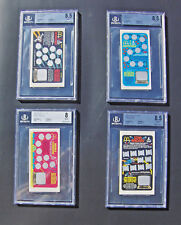VERY RARE AUTHENTIC ANTIQUE REPRODUCTION CHRISTOPHER COLUMBUS LETTERS -READ-

When you click on links to various merchants on this site and make a purchase, this can result in this site earning a commission. Affiliate programs and affiliations include, but are not limited to, the eBay Partner Network.
VERY RARE AUTHENTIC ANTIQUE REPRODUCTION CHRISTOPHER COLUMBUS LETTERS -READ-:
$50000.00
c. 1493 VERY RARE AUTHENTIC ANTIQUE REPRODUCTION CHRISTOPHER COLUMBUS LETTERS
EACH PAGE MEASURES 22.5" x 16". THEY ARE QUITE LARGE AND ON A FINE QUALITY PAPER.THIS IS ONE OF THE 1493 COPIES OF THE ORIGINAL LETTER WRITTEN IN SPANISH AND TRANSLATED INTO ENGLISH. YOU ARE GETTING BOTH THE SPANISH VERSION AND THE ENGLISH TRANSLATION. OBTAINED FROM AN ESTATE. PLEASE ASK ANY QUESTIONS. THANKS FOR LOOKING.
A letter written by Christopher Columbus on February 15,1493, is the first known document announcing the results of his first voyagethat set out in 1492 and reached the Americas. The letter was ostensiblywritten by Columbus himself, aboard the caravel Niña, on the return leg of hisvoyage. A postscript was added upon his arrival in Lisbon on March 4, 1493, andit was probably from there that Columbus dispatched two copies of his letter tothe Spanish court.
The letter was instrumental in spreading the news throughoutEurope about Columbus's voyage. Almost immediately after Columbus's arrival inSpain, printed versions of the letter began to appear. A Spanish version of theletter (presumably addressed to Luis de Santángel), was printed in Barcelona byearly April 1493, and a Latin translation (addressed to Gabriel Sánchez [es])was published in Rome around a month later (ca. May 1493). The Latin versionwas swiftly disseminated and reprinted in many other locations—Basel, Paris,Antwerp, etc.—still within the first year of his arrival.
In his letter, Christopher Columbus claimed to havediscovered and taken possession of a series of islands on the edge of theIndian Ocean in Asia; Columbus was not aware that he had stumbled upon a newcontinent. He described the islands, particularly Hispaniola and Cuba,exaggerating their size and wealth, and suggested that mainland China probablylay nearby. He also gave a brief description of the native Arawaks (whom hecalled "Indians"), emphasizing their docility and amenability, and theprospects of their conversion to Catholicism. However, the letter also revealedlocal rumors about a fierce man-eating tribe of "monsters" in thearea (probably Caribs), although Columbus himself disbelieved the stories, anddismissed them as a myth. The letter provides very few details of the oceanicvoyage itself and covers up the loss of the Flagship of his fleet, the SantaMaría, by suggesting Columbus left it behind with some colonists, in a fort heerected at La Navidad in Hispaniola. In the letter, Columbus urges the Catholicmonarchs to sponsor a second, larger expedition to the Indies, promising tobring back immense riches.
A slightly different version of Columbus's letter, inmanuscript form, addressed to the Catholic monarchs of Spain, was found in1985, part of the Libro Copiador collection, and has led to some revision ofthe history of the Columbus letter.
The two earliest published copies of Columbus's letter onthe first voyage aboard the Niña were donated in 2017 by the Jay I. KislakFoundation to the University of Miami library in Coral Gables, Florida, wherethey are housed.
"The Letter of Columbus on the Discovery ofAmerica"
Route of Columbus's first voyage
Christopher Columbus, a Genoese captain in the service ofthe Crown of Castile, set out on his first voyage in August 1492 with theobjective of reaching the East Indies by sailing west across the AtlanticOcean. Instead of reaching Asia, Columbus stumbled upon the Caribbean islandsof the Americas. Convinced nonetheless he had discovered the edges of Asia,Columbus set sail back to Spain on January 15, 1493, aboard the caravel Niña.According to the journal of his voyage, on February 14, Columbus was caught ina storm off the Azores islands. The resulting poor condition of his ship forcedhim to put in at Lisbon (Portugal) on March 4, 1493. Columbus finally arrivedat Palos de la Frontera in Spain eleven days later, on March 15, 1493.
During the return journey, while aboard the ship, Columbuswrote a letter reporting the results of his voyage and announcing his discoveryof the "islands of the Indies". In a postscript added while he wasidling in Lisbon, Columbus reports sending at least two copies of the letter tothe Spanish court—one copy to the Catholic Monarchs, Ferdinand II of Aragon andIsabella I of Castile, and a second copy to the Aragonese official Luis deSantángel, the principal supporter and financial backer of Columbus's expedition.
Copies of Columbus's letter were somehow picked up bypublishers, and printed editions of his letter began to appear throughoutEurope within weeks of Columbus's return to Spain. A Spanish version of theletter (based on the letter he sent to Luis de Santángel) was printed inBarcelona probably in late March or early April 1493. A Latin translation ofthe letter (addressed to Gabriel Sanchez) was printed in Rome about a month later.Within the first year of his arrival, eight more editions of the Latin versionwere printed in various European cities—two in Basel, three in Paris, anothertwo in Rome and another in Antwerp. Already by June 1493, the letter had beentranslated by a poet into Italian verse, and that version went through multipleeditions in the next couple of years. A German translation appeared in 1497.The rapid dissemination of Columbus's letter was enabled by the printing press,a new invention that had established itself only recently.
Columbus's letter (particularly the Latin edition) forgedthe initial public perception of the newly discovered lands. Indeed, until thediscovery of Columbus's on-board journal, first published in the 19th century,this letter was the only known direct testimony by Columbus of his experienceson the first voyage of 1492. It is estimated that, on the whole, between 1493and 1500, some 3,000 copies of the Columbus letter were published, half of themin Italy, making it something of a best-seller for the times. By contrast,Columbus's 1495 letter of his second voyage and his 1505 letter of his fourthvoyage had only one printing each, probably not exceeding 200 copies.
Original versions of Columbus's letter, written by his hand,have never been found. Only the printed editions—Spanish and Latin—are known.However, a third version of the letter, contained in a 16th-century manuscriptcollection known as the Libro Copiador, was discovered in 1985. This manuscriptversion differs in several significant ways from the printed editions and,although its authenticity is still tentative, many believe the Copiador versionto be a closer rendition of Columbus's original missive.
VERY RARE AUTHENTIC ANTIQUE REPRODUCTION CHRISTOPHER COLUMBUS LETTERS -READ-:
$50000.00

Related Items:
VERY RARE 2005 DUNHILL NAMIKI MAKI-E SAKURA ROSE FOUNTAIN PEN NEW BOXED
$225000.00
Disney Eureka, A California Adventure Parade Float, Dragon, Very Rare.
$175000.00
LIMITED VERY RARE 1982 Graded (4) 8-8.5 Cards UNSCRATCHED SET - Atari McDonalds
$150500.00







